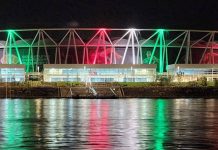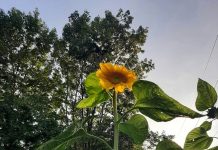In the midst of the smoke and blur of war, it’s the wide, unblinking eyes that demand attention.
T.L. Harby’s drawing shows a young soldier, helmet unbuckled, dog tags dangling, staring off into the oblivion. Behind him, ominous black smoke hovers over the silhouettes of other soldiers running behind.
Titled “The Face of War,” it was sketched by Harby in the midst of the Okinawa invasion. He was fighting alongside the man, only stopping briefly to capture the scene in his job as a combat artist.
“It’s haunting. This captures the effect that war had,” said Gregory Reinhardt, Harby’s son. “It’s history. This is part of America.”
[sc:text-divider text-divider-title=”Story continues below gallery” ]
“Faces of War: The WWII Combat Art of T.L. (Stoney) Harby” resurrects artwork that Harby completed during the war. More than 30 finished drawings and rough sketches that he worked on in the midst of battle, along with photos, letters, sketch books and other mementos from World War II, are on display at the University of Indianapolis.
Most of this work will be displayed in public for the first time. Although Harby died in 2011, his family hopes that bringing it to light will bring more appreciation for him and the work of the combat artist.
Capturing moments
“It’s a fascinating story. While at the same time being a soldier, these men were not only armed with a gun but with drawing supplies,” said Mark Ruschman, gallery director of the Christel De Haan Fine Arts Center at the university. “As an artist, (Harby) could provide a more emotional attachment to the subject matter.”
Reinhardt is a Marine Corps veteran, lending additional meaning to the emotion behind the exhibit. The southside resident and professor of anthropology at the University of Indianapolis organized and helped curate the show.
The drawings follow Harby’s service from Camp Pendleton in California, where he received his training, to Hawaii to the South Pacific and Okinawa.
Harby captured important moments in the war effort as well. He captured the first image of the American flag flying over the deserted Yokosuka naval base in Tokyo.
One of his scenes shows dozens of troop carriers cruising through the water toward Okinawa, where smoke rises from the explosions caused by bombing raids.
Portraits of individual soldiers show formal young men and women in their pressed uniforms. Another piece portrays soldiers relaxing in a military canteen. A partially finished work shows soldiers relaxing in their bunks playing guitars and singing.
“It’s not all about death and destruction; some of it is scenes that you wouldn’t expect from combat,” Reinhardt said. “He was a combat artist. This was part of combat, too.”
Other pieces paint a different picture. Harby drew an unhappy-looking soldier being transported between ships in a basket along a pulley system, while raging seas crest beneath him.
One drawing shows a forelorn, miserable-looking soldier slouched on the deck of a ship. Harby didn’t leave notes as to why the man looked so sad, but it conveys the exhaustion and emotion during the war.
Though the drawings aren’t gruesome, Harby did capture the casualties of the war. Certain scenes show dead Japanese soldiers, as well as wounded from both sides.
“Part of their job was strictly historical records for the military, but part of it was to show people back home what was going on,” Reinhardt said.
True essence of war
Harby, a private first class with the U.S. Marine Corps, was one of more than 100 servicemen-artists who took part in World War II. He was 21 and working in Los Angeles as a commercial artist when Japan attacked Pearl Harbor. He enlisted three weeks after the attack, and his training as an artist led him to be assigned as a serviceman-artist for the 6th Marine Division.
Combat arts programs were formed through the Navy, the Army and the Marine Corps during World War II, picking back up efforts that had been started in the first World War. Life Magazine and other publications also sent artists to cover the battles and life on the fronts.
Military officials wanted artists to capture all areas of the war effort — the landscapes, the victims of battle, the soldiers and natives impacted by the fighting.
At no time were the artists intended to do official portraits. This was an effort to capture the true essence or spirit or war, said Brig. Gen. Robert L. Denig, director of public relations for the U.S. Marine Corps at the time.
“A special case for art in time of war may be made, for it is then that man’s spiritual, as well as physical, being is most severely in need of sustaining strength,” he wrote in 1941. “Whatever provides the people good cheer, material for reflection and inspiration is an essential contribution to a nation’s total effort.”
Gaining momentum
Reinhardt was familiar with his father’s combat artistry. But he had never seen the entirety of the collection until after Harby died in 2011. He and his sister, Karen Hambali, were cleaning out their father’s apartment when they found the drawings he had made.
“I had seen some of his World War II art, but not all of it together. Some of his larger pieces, I had never seen at all,” he said.
Reinhardt ended up bringing most of his drawings and other work back to Indianapolis with him. Over time, he had mentioned to members of the University of Indianapolis art and design faculty about Harby’s work and time as a combat artist.
Momentum started to build for a possible show. For the university, it was an opportunity to expose students and the community to a lesser-known aspect of history.
“The gallery is always trying to bring new things in for the students and general public to see,” Ruschman said. “I was familiar with the combat-artists program, but my experience talking to students and people coming to the gallery is that this is something unique that people don’t know about.”
Reinhardt, Hambali and her son, Daniel Hambali, all helped put the exhibit together. Daniel Hambali funded the project.
Combat artists were expected to fight alongside their fellow soldiers. They made extremely dangerous landings throughout the Pacific theater, taking cover and making sketches on the beaches during battle.
Adding context
The exhibit features some of those rough drawings from Harby’s sketch book. The shapes are blurred and incomplete, with notations for where certain colors would go later on.
Side-by-side with finished works, it’s easy to see how Harby fleshed out and detailed the work.
But the process also shows what combat artists could do that no photographer could — add nuance and context to a moment.
“Photography captures an instant, and they’re stuck with that, if you don’t get the right shot,” Reinhardt said. “Combat artists could come up with different types of products than photographers could.”
After the war, Harby worked as a matte artist for film studios, helping create such masterpieces as “The Ten Commandments” and “The Bishop’s Daughter.” He also did work as a commercial portrait painter. He eventually settled in Arizona, specializing in Western-inspired art under the name Stoney Harby.
After the show closes Dec. 11, the family plans to take the artwork and donate it to the National Museum of the Marine Corps. The museum already has one of Harby’s wartime drawings, but this will give them a more complete collection.
“It’s a heritage that no one should forget,” Reinhardt said.
[sc:pullout-title pullout-title=”If you go” ][sc:pullout-text-begin]
“Faces of War: The WWII Combat Art of T.L. (Stoney) Harby”
What: A exhibition of the combat art of T.L. Harby created during and after World War II
When: Through Dec. 11
Where: Cristel DeHaan Fine Arts Center, 1400 E. Hanna Ave., Indianapolis, on the University of Indianapolis campus
Hours: Gallery is open 9 a.m. to 9 p.m. Monday through Friday. Closed weekends and holidays
Information: uindy.edu/arts
[sc:pullout-text-end]




